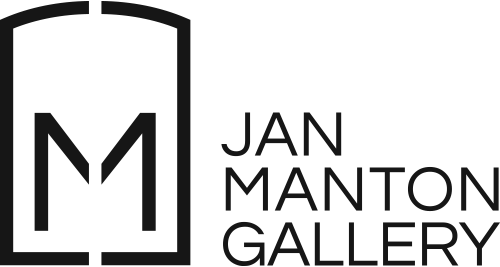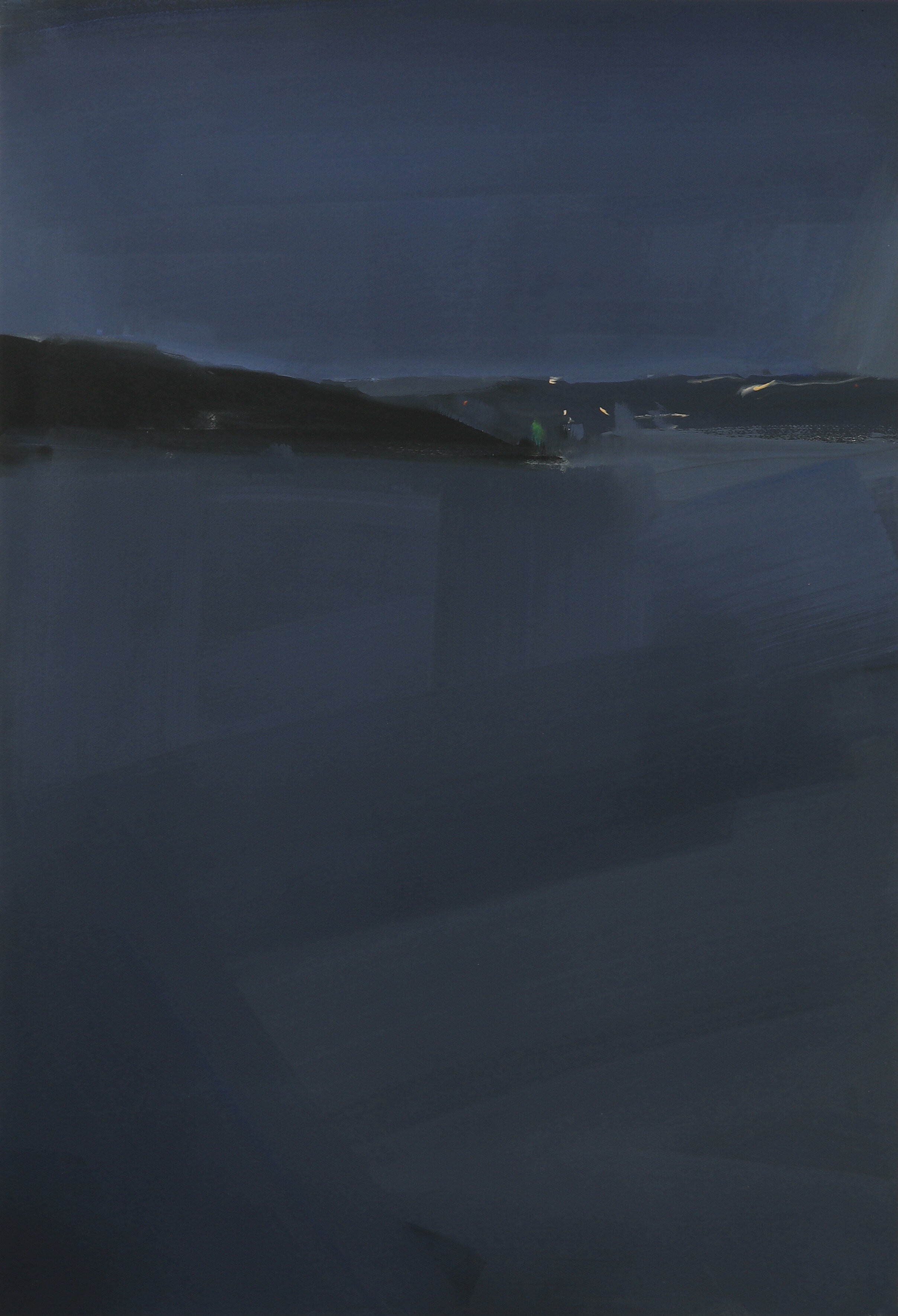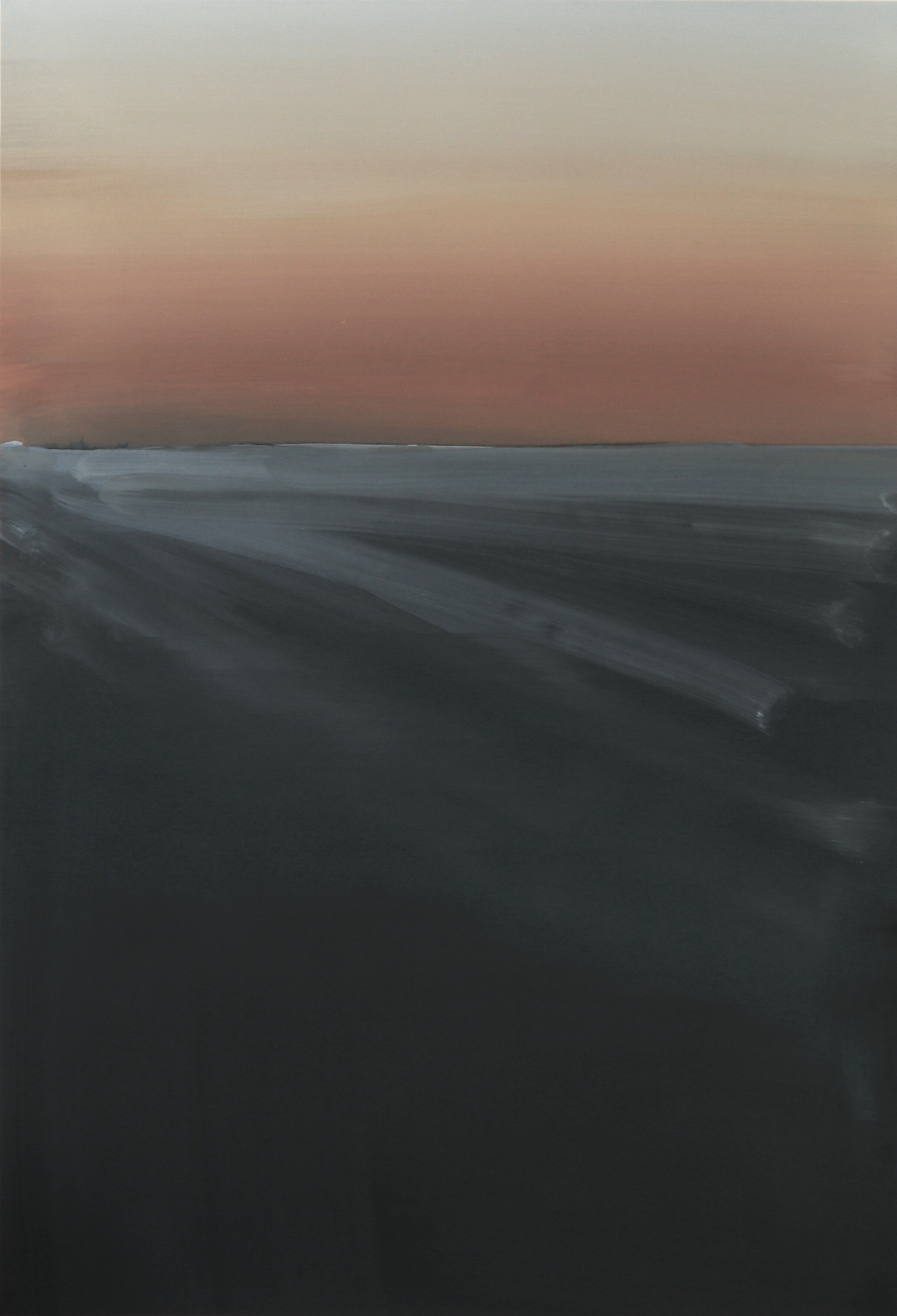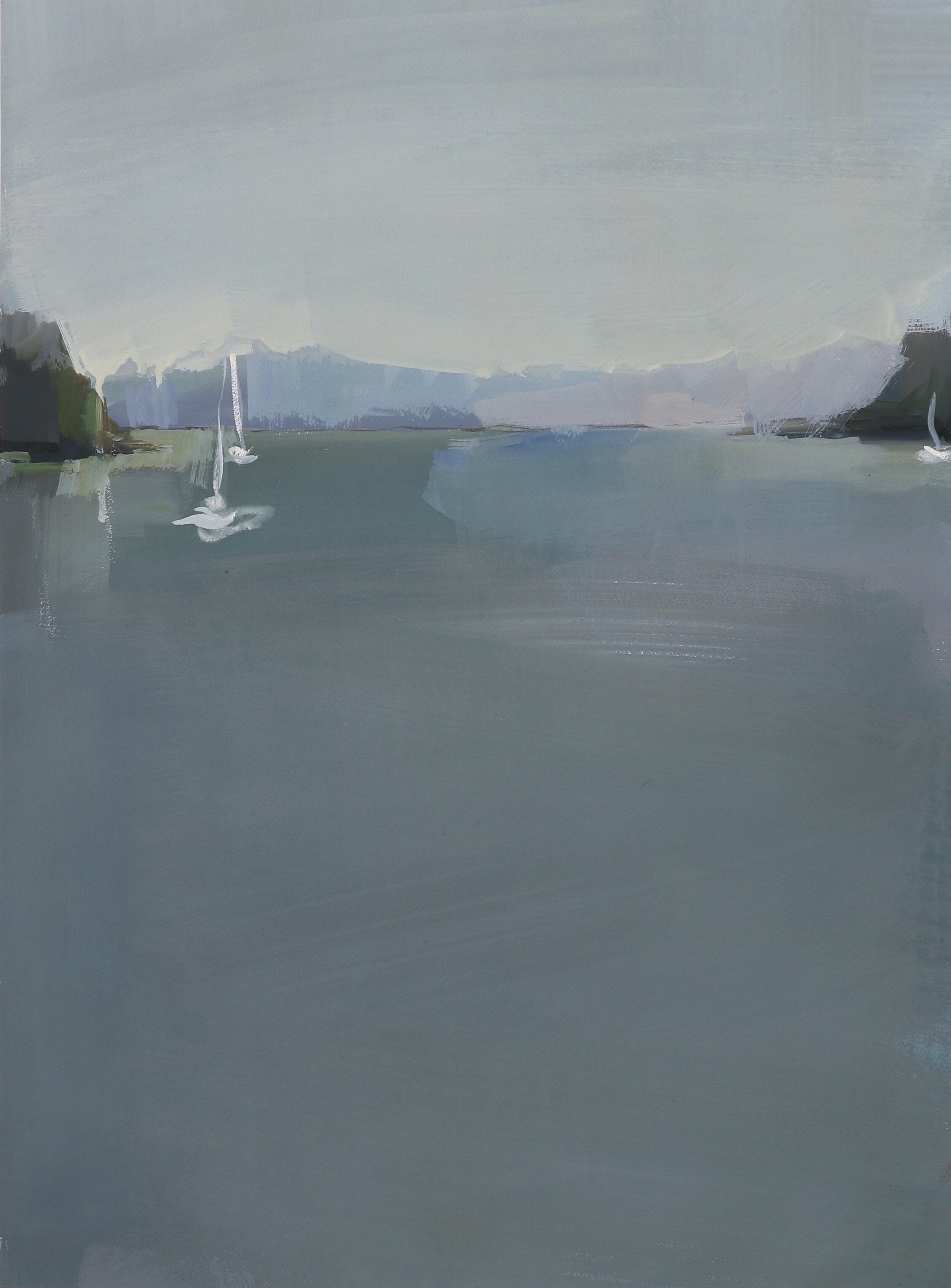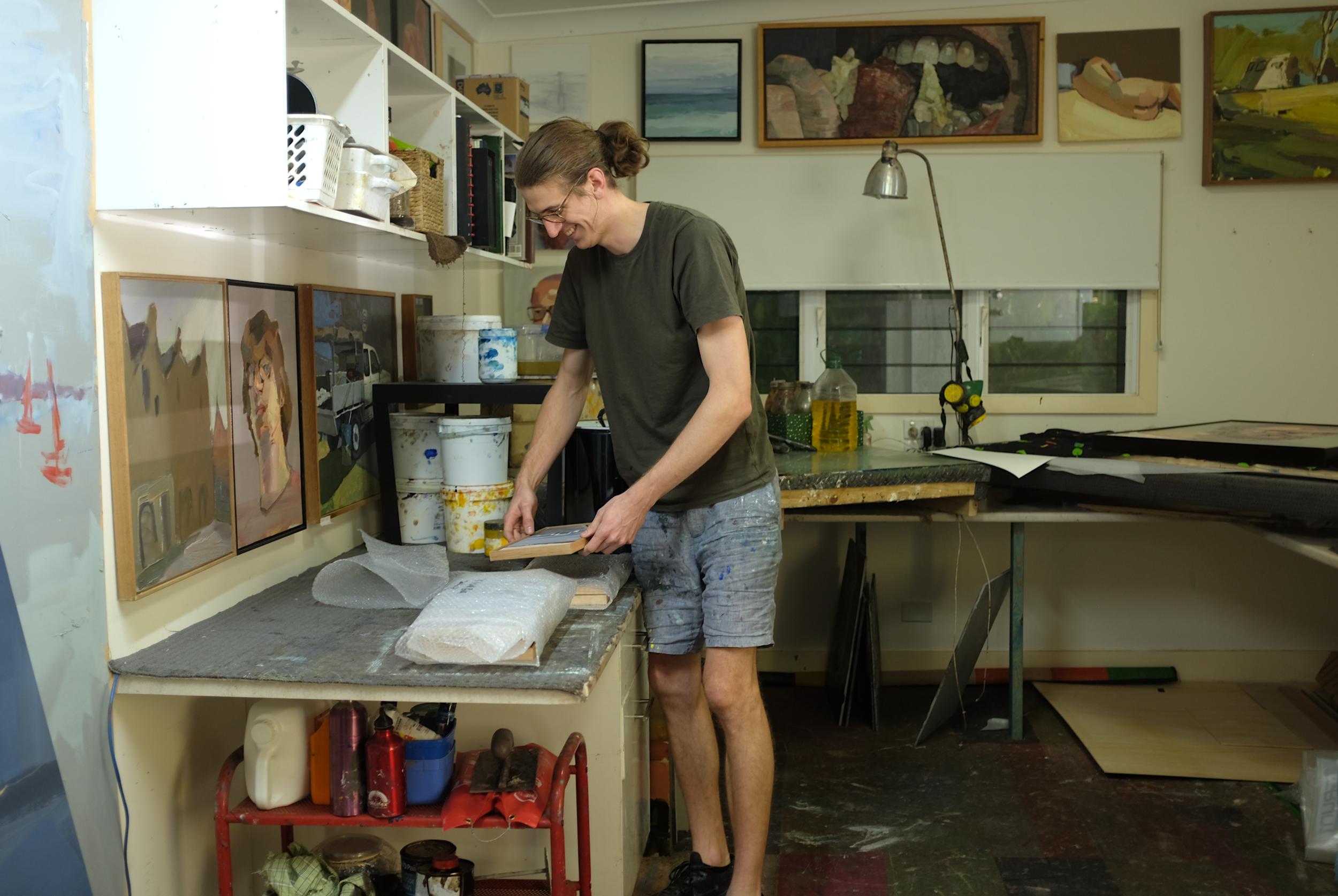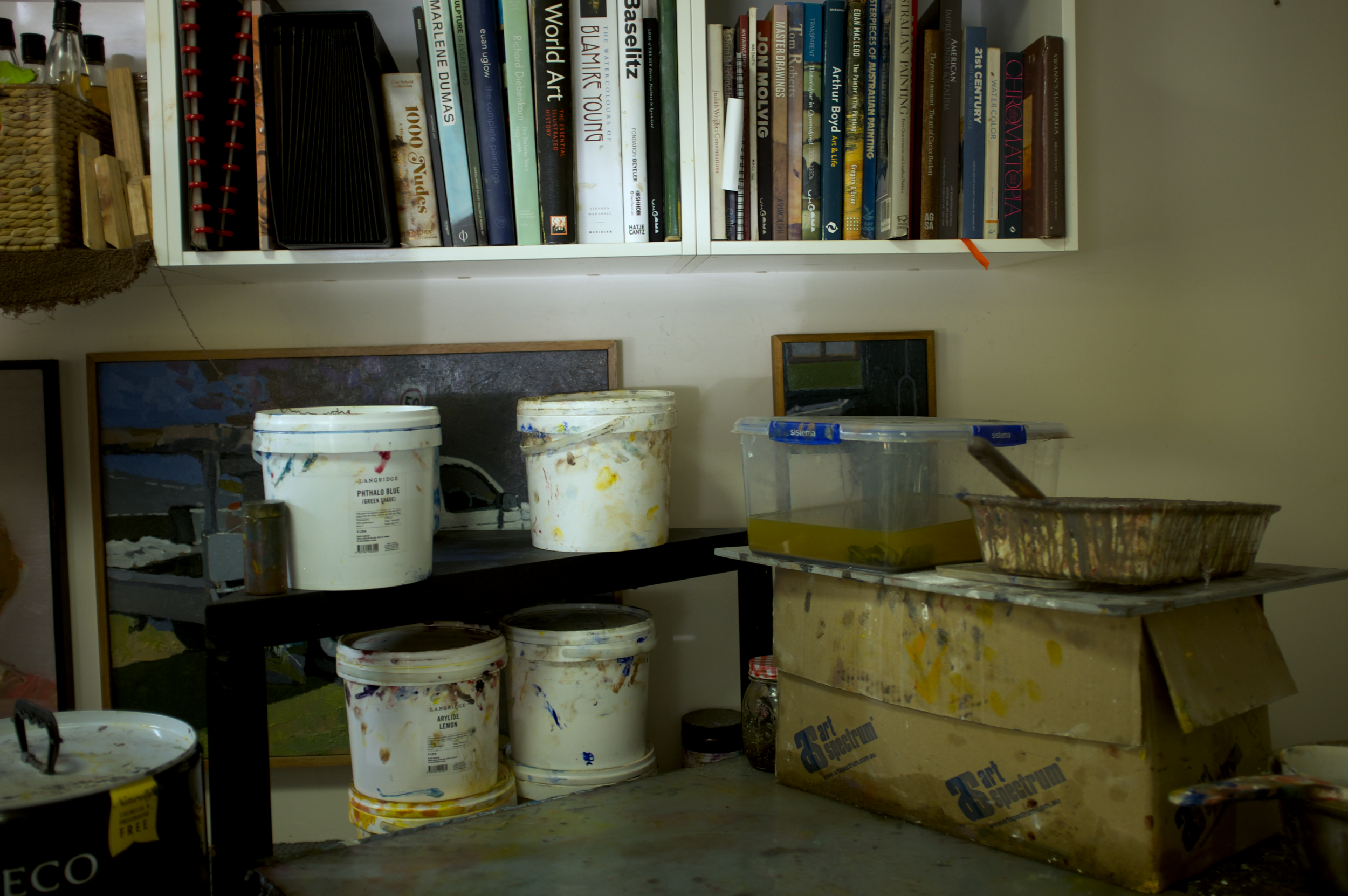From The Studio— Interview with Dylan Jones | 24.09.2021
Photography: Mark Dobson. Image courtesy of the artist and Jan Manton Gallery.
Jan Manton Gallery visited Dylan Jones's studio in the lead up to his upcoming solo exhibition Room with a View, 6 - 24 October 2021. During our visit, we spoke to Jones about his latest series of works, including his newfound use of gouache instead of his typical home-made oil paints, and his approach to painting landscapes en plein air.
Gallery Manager Taylor Hall, Gallery Assistant Zali Matthews and Media & Comms Intern Embie Tan Aren sat down with Jones to learn more…
Taylor Hall (TH): Hey Dylan, thank you for talking to us today! Your upcoming exhibition Room with a View consists of works made with gouache on paper, which is very different from your previous oil paintings.
Dylan Jones (DJ): Yeah, it is! I know oil paint very well, especially since I make it myself from raw ingredients. After such a unique year, I wanted to try something different. At first, I made bronze cast sculptures for my show Tossed Aside (5–15 August 2021), which was an entirely new process. Then a few of my friends who have used gouache were talking about it in somewhat of a negative way. They mentioned that it was a bit of a battle, and that it took them quite a long time to manipulate the medium. It doesn’t really have the ‘beauty’ of oil paint when it comes out of the tube.
TH: Gouache has a flatness and it’s a bit grittier, whereas in your previous oil paintings, every gesture is almost sculptural, since there are so many distinguishable layers.
DJ: Yeah. It’s still quite similar to oil paint where I just do it all alla prima (on first attempt). If it doesn't work, it’s very rare I will work back into it. I'm still using very large paintbrushes, and I'm still using the same tools, although this time I’ve used synthetic paint brushes instead of the hog hair brushes I use for oil paint. As a result, it feels like a similar process, but the outcome is different.
In transitioning to gouache, I wanted to try something new this year. It was also a pragmatic choice, as I painted most of the small works in this show en plein air (in open air). The series started when I went down to Sydney and stayed at Kirribilli in an apartment that faced east, away from the iconic views of the Harbour Bridge and Opera House. I don’t really care, or want people to know, the location of these works. To me, they’re not site specific. It’s just more about water, gouache, and colour. I was looking out towards Cremorne and Middle Head, which is where Tom Roberts and Arthur Streeton used to paint quite a lot. I went to those places, and they were very beautiful, but too beautiful for me to paint. I don't love painting beautiful pictures.
TH: That’s something you’ve focused on quite a bit, even in your paintings of nudes. Traditionally, there's such an obsession with the beauty and aesthetic of a female body; the sumptuous nature of skin, or the splendour of a woman. Instead, you focus on the way paint sculpts the human form. You paint as if the body is a landscape.
Zali Matthews (ZM): And you really seem to revel in ugliness.
DJ: Most of my works focus on abandoned subjects! When I was putting this show together and I got to Sydney Harbour, I almost turned around because I thought it was too picturesque. Then I thought: no, Sydney Harbour is a challenge. How am I going to do this? So, I went to the places that Tom Roberts and Arthur Streeton painted, and I thought, this is too pretty. No matter what time of day I paint this, it's going to be pretty. There was this large window in the Kirribilli apartment that looked over the ferry stop. You'll be able to see the ferry stop and the building that's next door in some of the works, as well as palm trees sitting in the way. I purposely picked the bits that were less 'postcard-y’. Gouache has been quite helpful in that way. The pigment quality is lower, so I can't paint as colourfully as I can with oil paint. Gouache is more soft and subtle, more atmospheric.
Embie Tan Aren (ETA): Did you find that you had to be a bit more imaginative with these works?
DJ: Yeah definitely, especially with the colours, since they're not overly colourful or intensely pigmented. It’s the first time I've used black since high school – pure black. Usually when I use black in painting, I mix it up using primary colours; a dark ultramarine blue, a cool crimson red, and a touch of yellow. Gouache wasn't dark enough as the pigment quality is lower (than oils).
TH: You've always made your own paint for a lot of your work, and as such you've had a lot of control over, and understanding of, the quality of the medium and the pigment.
DJ: Yeah! Which I haven't had in this series. I don't know much about gouache at all.
TH: It would have been a completely new experience. How did that feel for you?
DJ: I was put in the deep end, but I think that was good because I felt free with the medium – I had no expectations. Most people paint with gouache and watercolour for studies, or for neat, tiny, and appealing pictures. Gouache is also very unforgiving. When it dries it becomes quite opaque and it's very sensitive.
With oil paint, you can scrape it off. You can literally get your finger into it and push the old into the new. Gouache, however, doesn’t have that workability. There’s a strong contrast between the old and the new. I've tried rubbing my finger into these gouache works, but because the paint is so thin, you rub it off, and then it somehow leaves this dark mark. You can see where you’ve moved your finger across the surface. So that's been a learning curve – there's no second chances, really.
Photography: Mark Dobson. Image courtesy of the artist and Jan Manton Gallery.
DJ: Yeah! I love the making part. My concept is my process. I'm not trying to paint a nude person to change people's perceptions of how women are viewed. I'm not painting a bridge over the river to make a comment on industrialisation. I paint a scene because I want people to know that it's interesting. That might be a nude, or a shoe, or a garbage bin. I'm interested in how objects translate on the picture plane, because I’ll no longer be referencing a thing. It all comes back to colour. For many years, I tried and failed to paint headlands in the distance with oil paint. On the other hand, when I tried with gouache, I succeeded immediately. Going forward, I think my practice will consist of more thinking time. It’s about refinement. If you only paint with a few pigments, it means that if one little mark goes ‘wrong’, the painting is ruined. It might be that the edge between two forms is too hard or the colours have a poor relationship to each other. You have nowhere to hide.
ETA: I think it's more focused in, and because it uses minimal pigments and compositions, it all becomes a lot more apparent where things are placed.
ZM: Is that why in art you often see a lot of artists moving from more detailed works to more abstracted or more minimal works as time progresses?
DJ: Yeah, I believe so. Even older self-portraits of me are neat. I like the fact that I can paint with detail, but it's not all that rewarding, because art is about the process towards the end. Artists are quite addictive people. We seek a euphoric moment. The euphoria in artmaking is so intense, I wish other people could feel it. It all comes back to the challenge and then the reward. I'm quite a positive person so I don't get bogged down in the failure, but there is a lot of failure in art. You just have to let go of it and see where it goes.
Photography: Mark Dobson. Image courtesy of the artist and Jan Manton Gallery.
Photography: Embie Tan Aren. Image courtesy of the artist and Jan Manton Gallery.
Photography: Embie Tan Aren. Image courtesy of the artist and Jan Manton Gallery.
TH: It's interesting that you mention not wanting your works to resemble 'postcards' when you’ve had a show titled Postcards (5 May - 5 June 2020), so of course it seems like a turn away from something you’ve previously explored. In that exhibition you created each work en plein air. This was very much an immersive experience for you, one that was invested in the landscape rather than in people or figures. How did your Postcards series inform your current show?
DJ: Well, this is the first time I have painted landscapes with no man-made objects in them. I've always had a car in the way, a boat, or a building. But there's probably a third of the show that is void of civilisation. I've always been interested in painting form and space. Some works in this show finally got rid of one of those things, which is form. So, for me, it's just space. I'm simplifying another element.
ZM: What has that process been like?
DJ: It's been harder for me because I'm quite obsessive. If I'm painting a shoe, I will just sit in a room for 20 hours a week just to be able to paint that shoe. Whereas in this show, I have had to paint less. If I spend too much time at the easel, I ruin the pictures, because I don’t give myself enough time to process the work.
TH: Yes, these works are so minimal!
DJ: Yeah! In a lot of the larger works, I've actually made up the subject matter, which I've never done before. For this show, I had to do a substantial amount of remembering, as I could only be in Sydney for a month prior to lockdown. So, I was a bit out of my element. I painted less but I've also thought more. I was able to tap into my visual memory! That was the hardest part about this show. However, I think it's been very beneficial, because I hope to do more of that in the future where I won’t have to rely on having an object in front of me. If I were to paint this show a year ago, I may not have been successful, because I wouldn't have had the competence or the aptitude. I hope maybe one day I can just sit in my studio and make up an artwork from scratch without having to go anywhere.
TH: On that note as well, I think of you as an artist who pushes towards a challenge rather than staying static. You're always wanting to learn something new or work in a different way. For example, you recently learned how to sculpt – such a surprising transition for you! Now you've moved on from oil painting, which you’ve mastered, to a completely different medium. Do you feel that, as an artist, constantly challenging yourself and moving towards different things is important?
DJ: Yeah, I think so. Even before I began exhibiting at Jan Manton Gallery, one of the first challenges I set for myself was painting en plein air. Then I tried painting night-time scenes en plein air; I scaled up my works; I painted water. When I have been travelling overseas, scale was the challenge; I was forced to paint works smaller than an envelope. And then the nudes; I had never painted the figure in that way before. Together Alone (9 September - 4 October 2020) was all about making the paint from scratch, which once again was a process challenge. In this show I chose gouache, because I wanted to paint on a smaller and more confined scale. I then realised that a good image is simply a good image, regardless of whether it’s been done in crayon, or in charcoal, or in gouache. Someone said to me while making this series, “Oh, they're going to be cheap because they're gouache”. And I said, no! A strong image is a strong image. Oil paint is the king of the world, apparently.
TH: It's because of the Renaissance. People can't let that go!
DJ: Yeah! And my biggest idols are all oil painters; Euan McLeod, Robert Malherbe and Janis Clarke, for instance. But I feel good stepping away from the implications of oil paint. I'm carving my own path, whether it's through sculpture or gouache. I just slowly want to get to that point where I can stand in this room and paint an abstract painting. I'm not there but there's elements in this show, such as empty landscapes and abstracted compositions, that varies dramatically from my previous work.
TH: Could you elaborate on your love of abstraction?
DJ: I think abstraction is the hardest challenge of all. With realist painting, you know the endpoint. You know that it's eventually going to look like what you see in front of you or a photograph. Abstraction, however, poses the biggest challenge, because you must decide if the image is successful or not.
TH: It appears that what is most important to you is your journey with the artwork's surface and its material, and the question of: when does the painting experience end? It feels like the best part for you is the making process.
Photography: Mark Dobson. Image courtesy of the artist and Jan Manton Gallery.
Maybe it is also about how one’s visual vocabulary improves. If I looked at that thing [points to an old paint palette hung on the wall] ten years ago, I would think it’s awful. Now I find merit in that object. It’s about having visual competency – taking time to really look, and to find meaning beyond representation.
TH: It's like drinking wine. You need to know the words to describe it and to really taste it for what it is, to be able to pull apart the intricacies of the flavours. You can start to separate the notes and truly appreciate its complexity.
DJ: It is, yeah. Now I am still working that out for myself. I've only just started the gouache so maybe I'm really putting myself out there. It's all just about understanding medium.
Dylan Jones’ exhibition Room with a View is showing at Jan Manton Gallery from October 6 - October 24, 2021
Interview conducted by Taylor Hall, Zali Matthews and Embie Tan Aren. Edited by Taylor Hall and Zali Matthews. Images by Embie Tan Aren. From the Studio content courtesy of Jan Manton Gallery and Dylan Jones.
